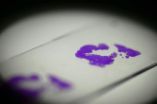(Press-News.org) ANN ARBOR – With precarious particles called polaritons that straddle the worlds of light and matter, University of Michigan researchers have demonstrated a new, practical and potentially more efficient way to make a coherent laser-like beam.
They have made what's believed to be the first polariton laser that is fueled by electrical current as opposed to light, and also works at room temperature, rather than way below zero.
Those attributes make the device the most real-world ready of the handful of polariton lasers ever developed. It represents a milestone like none the field has seen since the invention of the most common type of laser – the semiconductor diode – in the early 1960s, the researchers say. While the first lasers were made in the 1950s, it wasn't until the semiconductor version, fueled by electricity rather than light, that the technology took off.
This work could advance efforts to put lasers on computer circuits to replace wire connections, leading to smaller and more powerful electronics. It may also have applications in medical devices and treatments and more.
The researchers didn't develop it with a specific use in mind. They point out that when conventional lasers were introduced, no one envisioned how ubiquitous they would become. Today they're used in the fiber-optic communication that makes the Internet and cable television possible. They are also in DVD players, eye surgery tools, robotics sensors and defense technologies, for example.
A polariton is part light and part matter. Polariton lasers harness these particles to emit light. They are predicted to be more energy efficient than traditional lasers. The new prototype requires 1,000 times less electricity to operate than its conventional counterpart made of the same material.
"This is big," said Pallab Bhattacharya, the Charles M. Vest Distinguished University Professor of Electrical Engineering and Computer Science and the James R. Mellor Professor of Engineering at U-M. "For the past 50 years, we have relied on lasers to make coherent light and now we have something else based on a totally new principle."
Bhattacharya's system isn't technically a laser. The term was initially an acronym for Light Amplification by Stimulated Emission of Radiation. Polariton lasers don't stimulate radiation emission. They stimulate scattering of polaritons.
In a typical laser, light--or more often electrical current-- is pumped into a material called a gain medium that's designed to amplify the signal. Before the pumping begins, most of the electrons in the gain medium are in their least energetic state, also known as the ground state. Once the light or current hits them, the electrons absorb that energy and move to a higher-energy state. At some point, more electrons are high-energy than are low-energy and the device is said to have achieved a "population inversion." Now any light or current that goes in has the opposite effect on the excited electrons. It kicks them down to the ground state and releases pent-up light in the process.
Polariton lasers don't rely on these population inversions, so they don't need a lot of start-up energy to excite electrons and then knock them back down. "The threshold current can be very small, which is an extremely attractive feature," Bhattacharya said.
He and his team paired the right material – the hard, transparent semiconductor gallium nitride – with a unique design to maintain the controlled circumstances that encourage polaritons to form and then emit light.
How it works
A polariton is a combination of a photon or light particle and an exciton – an electron-hole pair. The electron is negatively charged and the hole is technically the absence of an electron, but it behaves as if it were positively charged. Excitons will only fuse with light particles under just the right conditions. Too much light or electrical current will cause the excitons to break down too early. But with just enough, polaritons will form and then bounce around the system until they come to rest at their lowest energy level in what Bhattacharya describes as a coherent pool. There, the polaritons decay and in the process, release a beam of single-colored light.
The beam they demonstrated was ultraviolet and very low power – less than a millionth of a watt. For context, the laser in a CD player is about one-thousandth of a watt.
"We're thrilled," said Thomas Frost, a doctoral student in electrical and computer engineering. "This is the first really practical polariton laser that could be used on chip for real applications."
The design the team used helped them achieve the beam with an electrical rather than light input signal. Getting the electrical current into the system requires electrodes sandwiching the gallium nitride and several layers of mirrors to render the electrical signal useable. Other groups' approaches put the electrodes outside the mirrors. Bhattacharya said it was tough to get the signal strong enough under those circumstances. So he deconstructed the sandwich. He put the mirrors on the sides of the gallium nitride and left the electrodes on the top and bottom.
INFORMATION:
The paper, "Room Temperature Electrically Injected Polariton Laser," will be published online in Physical Review Letters on June 10. The work was funded by the National Science Foundation.
A new way to make laser-like beams using 1,000x less power
2014-06-05
ELSE PRESS RELEASES FROM THIS DATE:
Stem cells found to play restorative role when affecting brain signaling process
2014-06-05
Putnam Valley, NY. (June 5, 2014) – A study by a Korean team of neuroscientists has concluded that when mesenchymal stem cells (MSCs; multipotent structural stem cells capable of differentiation into a variety of cell types) are transplanted into the brains of mice modeled with Alzheimer's disease (AD), the cells stimulate neural cell growth and repair in the hippocampus, a key brain area damaged by AD. The finding could lead to improved AD therapies.
The study will be published in a future issue of Cell Transplantation and is currently freely available on-line as an ...
Research shows compassion and euthanasia don't always jibe
2014-06-05
New research from Case Western Reserve University found that compassion can produce counterintuitive results, challenging prevailing views of empathy's effects on moral judgment.
To understand how humans make moral choices, researchers asked subjects to respond to a variety of moral dilemmas, for instance: Whether to stay and defend a mortally wounded soldier until he dies or shoot him to protect him from enemy torture and enable you and five other soldiers to escape unharmed.
Leading research has said people make choices based on a struggle within their brains between ...
Alcohol-related terms can increase aggression
2014-06-05
New psychology research shows that exposing people to alcohol-related words can influence aggressive behaviour in ways similar to actually consuming alcohol.
Researchers found however that this aggressive behaviour occurred when people were subjected to provocation in a way that was not a clear-cut insult.
Although it has been long known that drinking alcohol can increase aggression, a team of five psychologists, including Dr Eduardo Vasquez of the University of Kent in the UK and others from two US universities, demonstrated in two experiments that participants exhibited ...
Future heat stroke treatment found in dental pulp stem cells
2014-06-05
Putnam Valley, NY. (June 5, 2014) – Scientists in Taiwan have found that intravenous injections of stem cells derived from human exfoliated deciduous tooth pulp (SHED) have a protective effect against brain damage from heat stroke in mice. Their finding was safe and effective and so may be a candidate for successfully treating human patients by preventing the neurological damage caused by heat stroke.
The study is published in a future issue of Cell Transplantation and is currently freely available on-line as an unedited early e-pub at: http://www.ingentaconnect.com/content/cog/ct/pre-prints/content-CT1100Tseng.
...
Science Elements podcast highlights chemistry for search-and-rescue missions
2014-06-05
The June feature of Science Elements, the American Chemical Society's (ACS') weekly podcast series, shines the spotlight on devices that use chemistry to locate people trapped in collapsed buildings. The episode is available at http://www.acs.org/scienceelements.
Every second counts when people are trapped in the rubble of a collapsed building. As survivors breathe in a confined space, oxygen levels go down and carbon dioxide levels go up, a potentially lethal combination. People also can have severe injuries from the falling walls and other debris.
In the episode, ...
State of wildland fire emissions, carbon, and climate research
2014-06-05
RIVERSIDE, Calif.—Scientists know that wildland fire emissions play a significant role in the global carbon cycle and that its principal component – carbon dioxide – is a primary driver of climate change. But predicting and quantifying the effects of potential future emissions is a difficult process requiring the integration of complex interactions of climate, fire, and vegetation. The current state of knowledge, critical knowledge gaps, and importance of fire emissions for global climate and terrestrial carbon cycling is the focus of nine science syntheses published in ...
Team demonstrates continuous terahertz sources at room temperature
2014-06-05
Imagine a technology that could allow us to see through opaque surfaces without exposure to harmful x-rays, that could give us the ability to detect harmful chemicals and bio-agents from a safe distance, and that could enable us to peer so deeply into space that scientists could better understand the formation of the universe.
All of these scenarios are possible with terahertz radiation, electromagnetic waves with lengths that fall between microwaves and infrared light. However, the potential of terahertz waves has yet to be reached because they are difficult to generate ...
Race could be a factor in head and neck cancer survival rates, MU researchers find
2014-06-05
COLUMBIA, Mo. — The national survival rates for African-Americans diagnosed with head and neck cancer have not improved in the last 40 years despite advances in the treatment and management of the disease, University of Missouri School of Medicine researchers have found in a new study.
More than 52,000 men and women in the United States currently are living with head and neck cancer. Using data from the National Cancer Institute's Surveillance, Epidemiology and Ends Results (SEER) program, MU researchers under the guidance of Mosharraf Hossain, M.D., assistant professor ...
Can mice mimic human breast cancer? MSU study says 'yes'
2014-06-05
Scientists have routinely used mice to replicate aspects of human breast cancer in an effort to find a cure to the most common type of cancer among women.
But how effective are these preclinical models in actually mimicking the disease and giving scientists the ability to develop real comparisons?
Eran Andrechek, a physiology professor in the College of Human Medicine at Michigan State University, has discovered that many of the various models used in breast cancer research can replicate several characteristics of the human disease, especially at the gene level.
The ...
Design of self-assembling protein nanomachines starts to click
2014-06-05
A route for constructing protein nanomachines engineered for specific applications may be closer to reality.
Biological systems produce an incredible array of self-assembling, functional protein tools. Some examples of these nanoscale protein materials are scaffolds to anchor cellular activities, molecular motors to drive physiological events, and capsules for delivering viruses into host cells.
Scientists inspired by these sophisticated molecular machines want to build their own, with forms and functions customized to tackle modern-day challenges.
The ability to ...



